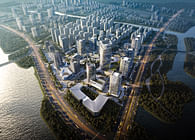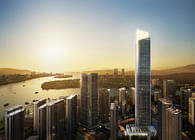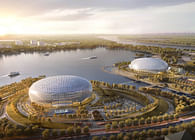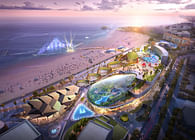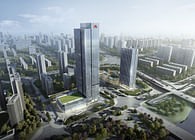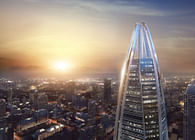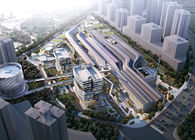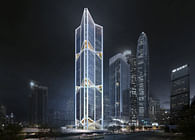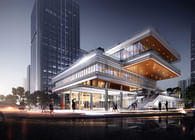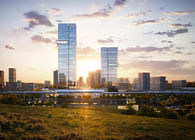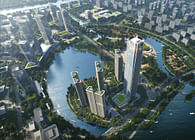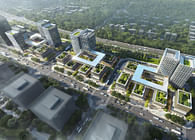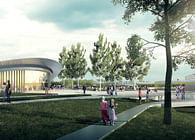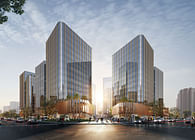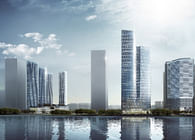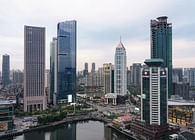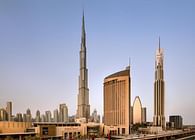
AECOM winning design of International competition with other competitors: Henning Larsen, Pelli Clark Pelli Architects, AIDEA and Leeser Architecture.
The new Senate building is designed as a sustainable and iconic capitol building for the Philippines Senate. The brief asked for an iconic, green and sustainable, functional and comfortable, open yet secure building. Creating a recognizable image of Philippines ingrained in the local culture is an important consideration in our design.
As a formal government building, the idea of equality was materialized in the symmetrical masterplan. Abstracting from the Sun’s radiating rays in the Filipino flag, four office towers fan outward from the central core, symbolizing the four pillars of democracy, namely Justice, Equality, Freedom and Representation. The spaces between the four towers in turn create drop-off entrances on the east and west, a formal flag plaza on the south, and a landscaped plaza on the north.
The Plenary Hall and amenity spaces for the four buildings are placed within the bridge connection, allowing easy access to all users and promotes social interaction. The indigenous Banaue Rice Terraces of the Philippines inspired green terracing on the internal facades, cascading down from the towers onto the roof deck, providing an urban oasis for the occupants of the building. The staff can enjoy access to the green spaces during the day without having to leave the building. It also provides a private and secure outdoor location for the Senate to host dignitaries and special events.
Ideas of sustainability were integrated at an early design stage, responding to the tropical climate in Philippines. We created a façade with balconies and overhangs to reduce radiant heat and added a privacy/ sun shading skin inspired by the National attire ‘Barong Tagalog’ for the glass facades. The sun baffles are also imbued with a perforated pattern that echoes the Barong Tagalog stitching patterns, creating sophisticated light and shadow effects on the facade.
The solid base on ground level relates to vernacular houses with a stone base and wooden top. It is detailed with diamond shaped perforations echoing the cross-stitch motif, creating some degree of transparency while ensuring more security on the ground elevation. The raised plaza at the 2nd floor provides a large gathering space for the public in the shade, with cross breeze and evaporative cooling, generated by water features around the building.
新的参议院大楼设计愿景希望创造具标志性,可持续发展和安全有保障的国会大楼。主要功能包括办公室、会议厅、公共礼堂和博物馆、员工设施和餐厅等。在我们的设计中,创造一个体现菲律宾文化特色的可辨识形象是一个重要考虑因素。作为一座正式的政府建筑,平等的理念体现在对称的总体规划中。从菲律宾国旗中抽象出太阳辐射的光线,四座办公楼从中心核心向外扇开,象征着民主的四大支柱,即正义、平等、自由和代表。四座建筑之间的空间创造了东西两侧的出入口,南侧的正式国旗广场和北侧的景观广场。参议会议厅和四座建筑的设施空间位于桥梁连接中,方便所有使用者进出,并促进社交互动。菲律宾的巴瑙大米梯田启发了内部立面的绿色梯田设计,从塔楼上溢出,延伸到屋顶平台,为建筑内的使用者提供了一个城市绿洲。
Status: Under Construction
Location: Manila, PH
My Role: Design Director, Lead Designer from competition stage to design development.
Additional Credits: Aecom project team: Vice President: Colin Franzen
Zhu Yinan, Wang Feng, Alex Xu Zhuoran, Clover Sixu, Shen Ruyi


